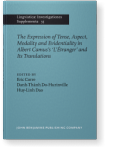Chapter 10
L’emploi des temps du passé dans la traduction du roman
L’Étranger en japonais
The objective of this study is to analyze the
use of past tense forms in Japanese in the translation of the novel
L’Étranger. Verbal forms such as
P(assé)C(omposé), IMP(arfait),
P(lus)Q(ue)P(arfait) and
P(assé)S(imple) appear respectively with 45,6%,
45,7%, 8,6% and 0,1% of occurrences in the novel. In the Japanese
version, the -ta form outranks the
-teita form by a ratio of 1 to 8 (88,7% vs
11,3%). We then ask ourselves the following questions: why is the
use of the form -teita, for which we often
establish a parallelism with the IMP in French from the point of
view of aspect and discourse, so rare? In what contexts do we
encounter coincidences/divergences in the translation of perfective
and imperfective forms between the two languages?
Article outline
- 1.Introduction
- 2.Le système verbal du japonais
- 3.L’observation générale des formes verbales employées en français
et en japonais
- 3.1La sélection des données
- 3.2La correspondance des formes verbales entre les deux langues
et les remarques
- 4.L’emploi de la forme -teita dans les situations
décrites au PC
- 4.1La valeur de simultanéité et la notion de durée
- 4.2La fonction discursive de la forme imperfective
- 5.L’emploi de la forme -ta dans les situations
décrites à l’IMP
- 5.1La notion d’habitude et d’itération
- 5.2Le rapport avec les types de verbe employé à la forme en
-ta
- Conclusion
-
Remarques
-
Références
Article language: French
